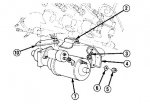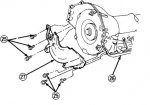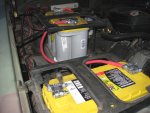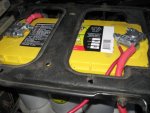After looking for a suitable answer for me and my starter woes, I am considering this modification. After looking at the problem with the starters I have been burning out I would rather take a small risk and try this as a fix. It does not solve the problem I have been having in terms of why my Starter Solenoids are burning up; but at least if I am continuing to burn them out the fix will be easier both on my attitude and my wallet.
Background: Starter after Starter has burned out in just a few months operation. The last episode caught me 3 hours away from home and the tow bill was $500. Can’t do that again. I have a new starter from a reputable builder (Wilson) it is the correct Gear Reduction 28 MT in 24Volt) and I will install that this week, weather permitting. Today I have replaced my Glow Plugs and spade connectors to same. I am also going to test battery cables under load and clean all terminal- any “bad” cables will be rebuilt from fresh components. The Dodhead (sorry could’t resist) has been long done and for good measure I even changed in a new starter relay. The batteries are charged and load tested fine. Other than starting issues plaguing me off-and-on for the past two years, I have been happy with performance of my M1009. So, I am installing a new remote 24 volt starter (ala Ford). Here’s why:
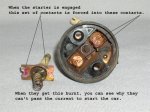
As the key is turned to START, the energy reaches the starter solenoid via the Purple Cable. It energizes the solenoid to close (spring loaded plunger, left). This opens the circuit, closing the contacts (indicated by pointers, right). The longer one holds the key to START, the hotter these become- on their way to a welded state; but even the briefest contact will create some bits to become welded and pitted until one of two things happen: a. the contact points are pitted, corroded and carbon covered to the point that no viable connection can be made (NO START). Or 2. They become welded, won’t separate and cause a “runaway” starter. The latter situation can lead to meltdowns of other components upline.
The remote solenoid moves the burned contacts problem off of the on-board solenoid because there is a “jumper” installed on the starter’s solenoid between the
Since I have already burned through 4 solenoids and repairs outlined in paragraph 2 may or may not solve the problem, I am opting to move the burn out solenoid problem to an easier to work on location somewhere on a convenient firewall.
The starter solenoid I am looking for is the type Ford uses; but I will invest in one that has the best reputation I can afford. Two actually; but the spare will be easily replaced and easily carried in the vehicle. I figure that if I do break down with another No Start that is starter Solenoid related, at least I can quickly get back on the road again and high-tail it back home without having to stop one started.
Will the new firewall-mounted remote last any longer than the one on the Delco Starter? I don’t know. I have heard that the strters solenoid that Ford uses have been known to fuse shut, causing a “Runaway”. Yet, my experience is that I am due for a similar situation anyway. Hopefully The maintenance and repairs from paragraph 2 will mean a fast start-up and contacts that will last longer; but again it seems only a matter of time before the Delco Starter Solenoid is going to fail, so I feel as though I’ll be in a better position to get on the road with the remote. We’ll see.
One question: Does the remote get 12 or 24 volts from the starter relay purple wire? It's 12v right?



